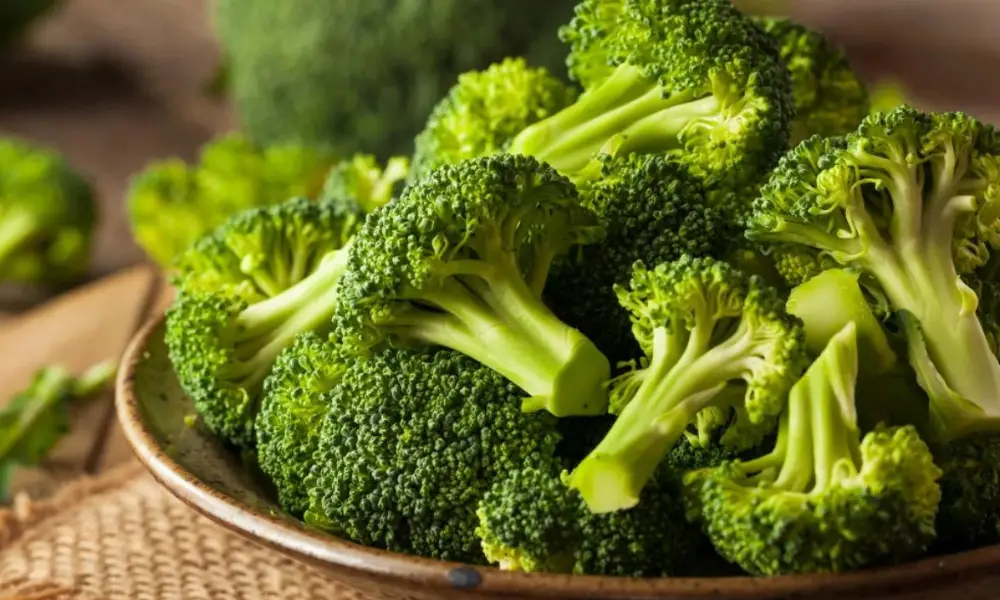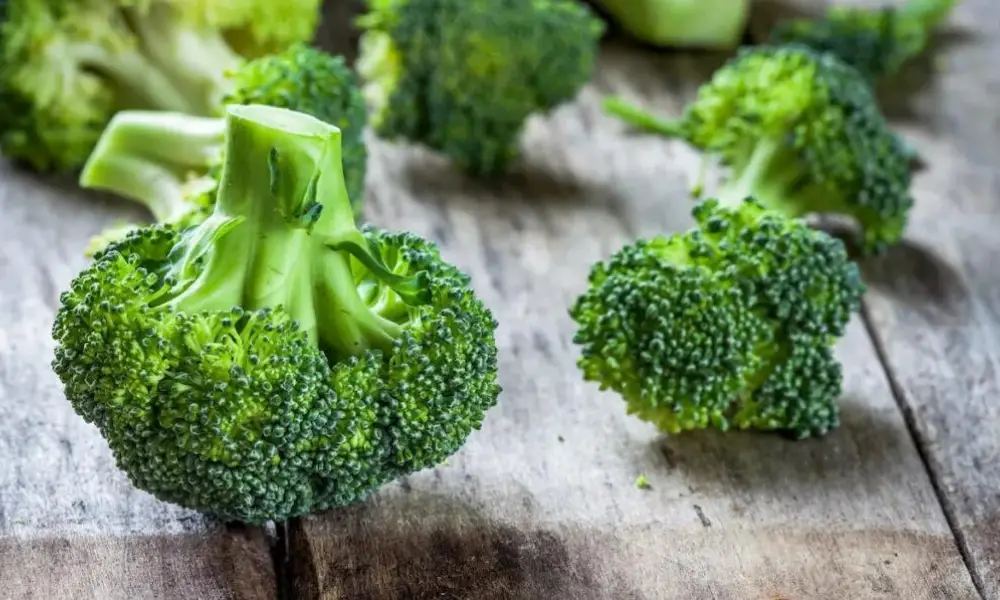To freeze fresh broccoli, ensure you have the right equipment. In a sink, add water and ice. Make sure to wait until you are almost ready to use the broccoli to add ice. This way, it won’t melt before you need it. Put a few pieces of broccoli in the water at a time, not the entire bag. It won’t reduce the simmer if you put in more than that; fewer pieces will make the process go faster.
Due to its dietary advantages, adaptability, and speedy cooking time, broccoli is a fantastic vegetable to keep on hand. However, freezing is an excellent alternative if you are unintentionally overbought or want to stock up for future meals (especially if you need to freeze up space in that crisper drawer). Just follow these easy steps to obtain fresh, crisp, tender broccoli whenever you want it.

How to Freeze Broccoli?
Trimming and Washing
Trimming and thoroughly cleaning your broccoli comes first. Cut the crowns into florets of the same size to accomplish this. The florets should be submerged in a sizable basin of cold water, stirred to remove any dirt or debris, and then thoroughly drained. Trim the ends and use a vegetable peeler to peel the stalks to prevent wastage of the stems. To cook and freeze with the florets, slice them into even pieces.
Getting Ready the Broccoli
You need to take a few steps before you can blanch the stalks. Before preparing, remove and discard the tough, woody stalks from the broccoli. Alternatively, you can just cut off the bottoms of the stalks after removing the rough outer skin with a vegetable peeler.
After that, soak the broccoli for about 30 minutes in cold, salted water. Any insects that might be there will be eliminated as a result. After thoroughly rinsing with cold water, swish it to get rid of the dirt. To ensure equal cooking, remove the broccoli and cut it into uniform stalks or pieces.
Put ice and water in a clean sink or a sizable container. After being blanched, the broccoli will be swiftly cooled in the ice water.
Steaming and Blanching
Broccoli must be boiled before freezing for it to keep bright green and crisp-tender once thawed. We advise steaming or blanching as two techniques.
For blanching, prepare a sizable bowl of ice water and a larger saucepan of salted water by bringing them both to a boil. Trimmed broccoli should be added to the boiling water in stages and cooked for 3 minutes or until bright green and crisp-tender. Make the transfer using a slotted spoon to the ice bath. The broccoli is shocked, maintaining its color and degree of doneness. Once totally cooled, drain well and use paper towels to pat yourself dry.
You’ll need a big pot with a steamer basket insert for steaming. Add the basket to the pot after adding a few inches of water to the bottom.
Melt over medium-high heat, then simmer. Trimmed broccoli should be added, covered with a tight-fitting lid, and cook for 5 minutes or until brilliant green and soft. After the broccoli has cooled fully, blot it dry. Shock it in a big bowl of ice water.
Proper Freezing and Storing
Broccoli that has been cooked and dried can be packaged for freezing. On a plate or sheet tray covered with parchment paper, arrange the broccoli in a single layer. Place in freezer and let there for 1 to 2 hours, or until totally firm. After being frozen, put in a plastic container or freezer bag that can be sealed. The broccoli should retain its fresh flavor for six to eight months and be free of freezer burn.
Put Together in Freezer Bags
Remove any air from the freezer bags before adding the frozen broccoli. When ready to use it in your preferred recipes, label, date, and keep in the freezer. Broccoli that has been blanched, wrapped, and frozen properly will keep for up to a year.
How to Prepare Frozen Broccoli After Thawing?
There are a few simple methods to use frozen broccoli when the time comes. To use your favorite dishes, place the full container in the refrigerator to defrost overnight. The frozen florets can alternatively be placed directly into a saucepan of salted boiling water for one to two minutes. Without overcooking, this causes the broccoli to defrost and heat. Another option is to put frozen broccoli straight into a skillet with butter and quickly fry until heated.
What do you Understand by Roasted Frozen Broccoli?
It’s difficult to boil frozen broccoli without it becoming mushy because of the water content when it’s frozen. One of the finest methods to prepare frozen broccoli is to roast it, which employs high heat and extracts moisture.
The oven temperature should be 400 degrees or above. Take the broccoli out of the freezer as the oven is heating up. Don’t let it thaw before cooking. Add a little olive oil, salt, and pepper to a bowl with the broccoli and toss to coat.
When roasting, use an oil with a medium-high smoke point. The temperature at which an oil starts to smoke and degrade is known as the smoke point. As a result, it loses nutritious value and gives food an unpleasant flavor. The Mayo Clinic also advises using avocado, corn, or canola oil instead of olive oil.
Spread the frozen broccoli in a uniform layer on a tray and place it in the preheated oven. Broccoli should be roasted until it is soft and the edges begin to brown. Remove and serve plain or sprinkle with freshly squeezed lemon juice, grated parmesan, or both.
Frozen Broccoli: Is it Just as Healthful as Fresh Broccoli?
Fortunately, frozen broccoli has similar health benefits to fresh broccoli.
Broccoli is normally harvested and frozen at its peak of freshness, preserving its nutritional content.
The blanching procedure that frozen broccoli goes through before being frozen can sometimes eliminate bacteria, retain nutritional value, and prevent spoilage, making it more nutrient-dense than fresh broccoli.
Even folic acid levels in frozen broccoli are on par with those in fresh broccoli.
What is the Nutritional Content of Broccoli?
Carbs
The majority of the carbohydrates in broccoli are fiber and sugar.
Fructose, glucose, and sucrose are the main sugars, with trace amounts of lactose and maltose.
However, there are just 3.5 grams of digestible carbs in one cup, making the total amount of carbs quite low (91 grams).
Fiber
A healthy diet should include fiber as a key component.
It can aid in weight loss, protect against several ailments, and support intestinal health.
2.3 grams of fiber, or 5–10% of the Daily Value, are found in one cup (91 grams) of raw broccoli (DV)
Protein
Your body is made up of proteins, which are essential for both growth and maintenance.
Compared to most vegetables, broccoli has a higher protein content than most, with protein making up 29% of its dry weight.
However, due to its high water content, 1 cup (91 grams) of broccoli only contains 3 grams of protein.
Minerals and Vitamins
The following vitamins and minerals are found in broccoli:
C vitamin and this vitamin is an antioxidant crucial for healthy skin and the immune system. Almost 70% of the DV is provided by a serving of raw broccoli that is 1/2 cup (45 grams).
K1 vitamin Vitamin K1—crucial for blood clotting and may improve bone health—is abundant in broccoli.
Folate (vitamin B9). For healthy tissue growth and cell function, folate is essential, especially for pregnant women.
Potassium. Potassium, a necessary mineral, is good for controlling blood pressure and preventing heart disease.
Manganese. Whole grains, legumes, fruits, and vegetables all contain significant levels of this trace element.
Iron. Iron is a necessary mineral that is used by your body for a variety of vital processes, including the transportation of oxygen by red blood cells.
In smaller doses, broccoli also has many other vitamins and minerals, offering a small amount of practically every vitamin you require.
How to Saute Frozen Broccoli?
Vegetables retain more essential nutrients, flavor, and crunchy texture when sautéed. Goodbye, mushy broccoli in army green! Broccoli may be quickly and easily added to your meal by sautéing it.
Instructions for sautéing frozen broccoli:
A skillet should be heated to medium, and your frozen broccoli should be added to the skillet (we recommend Broccoli Remix or Vegetable Medley).
Don’t add water; only one tablespoon of olive oil.
Stirring occasionally, heat uncovered over medium-high for 5-7 minutes, or until well cooked.
If you prefer caramelized vegetables, you might want to cook them longer so they can brown.
Enjoy!
How to Select Broccoli?
Pick a head of broccoli that has dense, dark-green buds that are tightly closed. The stalks shouldn’t have any browning or yellowing and should be green and healthy-looking. Look at the stem end; it shouldn’t be dried up or shriveled and appear as though it was cut recently. Since broccoli is a flower, a little bit of yellow flowering at the tips is acceptable as long as the rest of the florets are healthy, vibrant, and green. However, it would help if you steered clear of florets that appear wilted and have a lot of yellowing, as this indicates that the broccoli is past its prime. A less-than-fresh bunch also has mushy areas and a rotting odor.
What are the Health Benefits of having Frozen Broccoli?
According to recent studies, having a supply of vegetables in your freezer will help you consume the appropriate amount daily. When you constantly have vegetables on hand, it is much simpler to consume a lot of them, and the freezer is the only area where you can store vegetables without worrying about them going bad.
Broccoli that has been frozen is simple to prepare because it has already been washed, sliced, and seasoned if you get Tommy’s!
It is Practical to Buy Broccoli from the Freezer
Frozen vegetables are advantageous for both your health and your pocketbook. Frozen foods have become more economical as they’re more widely accessible at grocery stores. When you buy frozen, there is less waste because there is less chance that it will go bad in your fridge before you prepare it, and frozen broccoli medleys may be divided up and kept in the freezer for a long time.
When purchasing fresh broccoli, you frequently pay by the pound, which includes the stem—which most of us don’t even eat! Your pocketbook will thank you for purchasing frozen broccoli because you only pay for the portion of the vegetable you will consume.
Frosted Broccoli is Healthy
Although there has been considerable discussion regarding the distinctions (as well as many myths! ), we know that frozen vegetables are equally as healthy as fresh vegetables. Frozen vegetables can sometimes be more nutrient-dense than their fresh counterparts. For instance, fresh broccoli contains 400% less beta-carotene than frozen broccoli.
Because they are harvested at ripeness and quickly frozen within 24 hours, frozen veggies retain a high level of nutrients. On the other hand, fresh veggies can travel for weeks before they get on your plate, losing flavor and nutrients.
Conclusion
Gardeners worldwide have an excess of fresh vegetables they wish to preserve as the summer draws close. There is just one method that works for broccoli, even though canning, dehydrating, and freezing are all excellent ways to store your yield.
While maintaining the vitamins and nutrients, this leafy green vegetable is packed with. Frozen broccoli is an excellent way to preserve summer’s luscious, rich taste. And if you don’t know how to freeze broccoli, don’t panic; it’s very easy.
